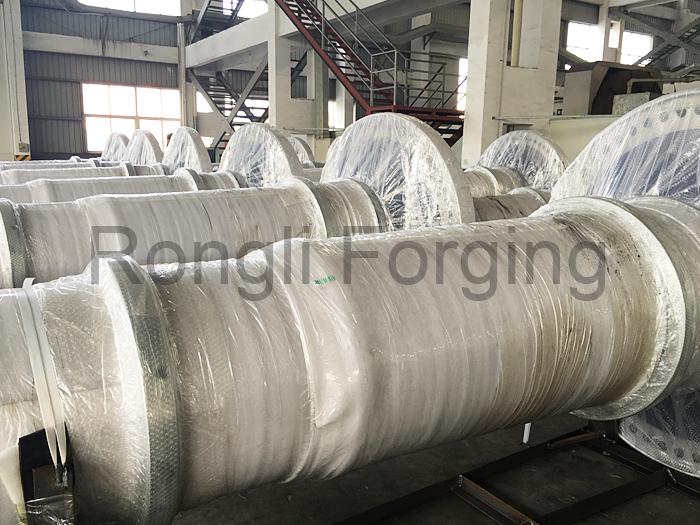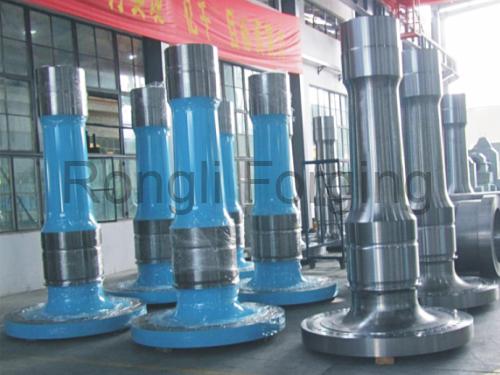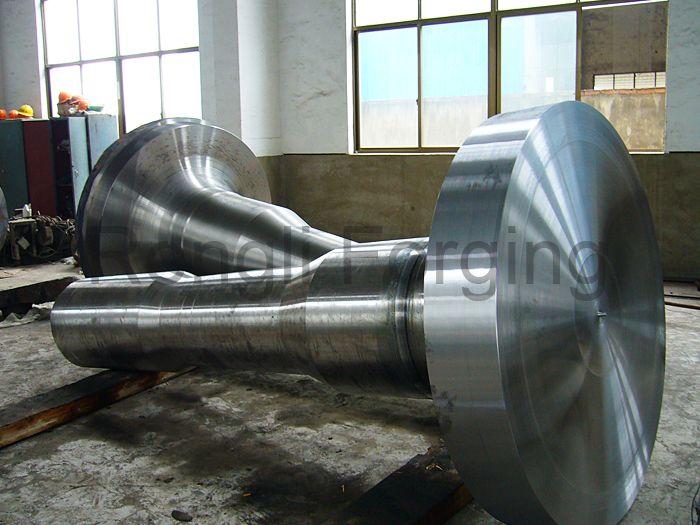
Wind turbine shaft reliability supports critical energy infrastructure. Operators in onshore and offshore wind farms rely on these components to maintain power output. Industrial sites, remote facilities, and research centers demand shafts that withstand harsh conditions. Consistent performance and durability help ensure stable energy supply in challenging environments.
Key Takeaways
- Robust wind turbine shafts are essential for reliable energy production in diverse settings like onshore and offshore wind farms, remote industrial sites, and mining operations.
- Strong materials and advanced designs help shafts resist heavy loads, fatigue, and harsh environmental conditions, ensuring long-lasting performance and reduced maintenance.
- Regular monitoring and predictive maintenance extend shaft life, prevent failures, and support stable power output across various renewable energy projects.
Wind Turbine Shaft Applications in Utility-Scale and Industrial Sectors

Onshore Wind Farms
Onshore wind farms form the backbone of renewable energy production in many countries. Operators install hundreds of turbines across vast landscapes to capture wind energy efficiently. Each turbine relies on a wind turbine shaft to transfer mechanical energy from the rotor to the generator. The shaft must withstand variable wind speeds, turbulence, and frequent load changes. Historical data shows that both horizontal and vertical axis turbines experience significant fatigue loads. Advanced monitoring systems, such as the Eigen Decomposition-KalmanNet, help operators estimate fatigue damage and optimize maintenance schedules. These technologies highlight the importance of robust shaft design for long-term reliability and performance.
| Aspect | Evidence Summary |
|---|---|
| Historical Evolution | Wind technology evolved from ancient uses to modern electric power generation. |
| Mechanical Design | Shafts must remain rigid and stable to ensure reliable operation. |
| Fatigue and Loads | Turbines face fatigue from turbulence and variable wind, requiring strong shafts. |
| Rotor and Shaft Role | The shaft links the rotor to the generator, making its durability essential. |
Offshore Wind Farms
Offshore wind farms operate in some of the harshest environments. Turbines face strong winds, saltwater exposure, and high humidity. The wind turbine shaft in these settings must resist corrosion and mechanical stress. Operators use corrosion protection measures, such as sacrificial anodes, to extend the lifespan of steel components. Over a 25-year period, a single offshore turbine may require up to 13 tons of anode material to protect its foundation and shaft. Comparative studies show that offshore turbines have higher failure rates than onshore units, mainly due to environmental challenges and larger turbine sizes. Innovations in bearing design and advanced failure analysis models, like Bayesian networks, help improve reliability and availability. These efforts support the durability and longevity of wind turbine shafts in offshore applications.
Note: Offshore wind farms demand advanced engineering solutions to ensure the structural integrity of every shaft, especially given the extended repair times and logistical challenges at sea.
Remote Industrial Facilities
Remote industrial facilities, such as oil refineries and chemical plants, often depend on dedicated wind turbines for power. These locations may lack easy access to grid electricity, making reliability a top priority. The wind turbine shaft must handle continuous operation and heavy mechanical loads. Preventive maintenance occurs every 2500 to 5000 hours, but unexpected failures can still happen. Predictive maintenance strategies, supported by real-time monitoring, help reduce downtime and extend shaft life. Operators choose shafts made from high-grade materials to ensure performance under demanding conditions.
- Key considerations for remote facilities:
- Continuous operation with minimal supervision
- Exposure to dust, temperature extremes, and vibration
- Need for robust, low-maintenance shaft designs
Mining Operations
Mining operations require a stable and reliable power supply to support heavy machinery and processing equipment. Wind turbines provide a sustainable energy source in remote mining sites. The wind turbine shaft in these applications must endure high torque, shock loads, and abrasive environments. Structural integrity remains a primary concern, as any failure can halt production and increase costs. Operators use advanced control methods and design optimizations to balance power output with shaft fatigue life. Power split transmission systems and distributed energy storage further enhance efficiency and reliability.
| Metric / Consideration | Description |
|---|---|
| Power Coefficient (Cp) | Modern turbines achieve 40-50% efficiency, below the Betz limit of 59.3%. |
| Capacity Factor | Reflects actual versus potential energy production. |
| Structural Integrity | Shafts must withstand mechanical stresses and loads. |
| Maintenance Considerations | Preventive and predictive maintenance extend shaft longevity. |
Mining companies invest in high-quality wind turbine shafts to minimize operational risks and ensure uninterrupted energy supply.
Wind Turbine Shaft Uses in Distributed and Specialized Projects
Microgrids
Microgrids deliver localized energy solutions for communities, campuses, and industrial parks. These systems often operate independently from the main grid, especially during outages or in remote locations. Wind turbines play a vital role in microgrids by providing clean, renewable power. The wind turbine shaft ensures the reliable transfer of mechanical energy from the rotor to the generator, supporting continuous operation. Operators select robust shafts to handle frequent start-stop cycles and variable wind conditions. In microgrids, durability and low maintenance requirements remain essential because technical support may be limited. The right shaft design helps maintain stable power output and reduces the risk of unexpected downtime.
Rural Electrification
Rural electrification projects aim to bring electricity to isolated villages and agricultural regions. Wind turbines offer a sustainable solution where grid extension is not feasible. The wind turbine shaft must withstand harsh weather, dust, and temperature extremes common in rural environments. Project planners prioritize components that require minimal maintenance and deliver long service life. Reliable shaft performance supports water pumping, lighting, and small-scale industry, improving quality of life and economic opportunities. By choosing high-quality shafts, rural electrification initiatives can ensure consistent energy access for underserved populations.
Note: In rural settings, the reliability of every mechanical component, including the shaft, directly impacts the success of electrification efforts.
Research and Testing Facilities
Research and testing facilities advance wind energy technology by evaluating turbine components under controlled conditions. Engineers use specialized test rigs equipped with sensors to measure shaft motion and deformation. For example, a 2013 study by Lutschinger and Howard analyzed shaft behavior using displacement sensors and fatigue theories, providing valuable insights into long-term loading effects. Leading centers such as Clemson University’s Restoration Institute and Fraunhofer IWES employ advanced hydraulic load systems to simulate real-world forces on drivetrain components. These facilities conduct highly accelerated life tests and follow international standards like IEC-61400-23 to validate shaft reliability and predict lifespan. Testing rigs can apply complex, multi-dimensional loads, replicating turbulent wind and operational stresses. This rigorous approach ensures that the wind turbine shaft meets the highest standards for safety and performance before deployment in the field.
- Major testing centers include:
- Wind Technology Testing Center (WTTC), Massachusetts
- Fraunhofer’s DyNaLab, Germany
- CENER, Spain
Hybrid Renewable Systems
Hybrid renewable systems combine wind turbines with solar panels, batteries, or other energy sources to create a balanced and resilient power supply. These systems address the intermittency of wind and solar by integrating multiple generation methods. Studies highlight the complementary nature of wind and solar, which helps stabilize power output and improve reliability. The wind turbine shaft plays a crucial role in these systems by efficiently converting mechanical energy to electricity, even as wind conditions fluctuate. Operators optimize shaft design to maximize efficiency and minimize wear. Energy storage solutions, such as batteries or pumped hydro, further enhance system stability. Advanced control techniques manage power quality and address challenges like harmonics from inverters. By focusing on system sizing and component reliability, hybrid renewable projects achieve higher efficiency and longer operational life.
| Hybrid System Benefits | Description |
|---|---|
| Improved Reliability | Balances wind and solar output for steady power supply |
| Enhanced Efficiency | Optimized shaft and turbine design increases energy generation |
| Grid Stability | Energy storage and advanced controls manage fluctuations |
| Reduced Maintenance | Durable shafts lower operational costs and downtime |
Key Requirements for Robust Wind Turbine Shafts

Load Handling and Durability
Engineers design wind turbine shafts to handle immense loads and resist fatigue over decades of operation. Forged shafts show a 26% increase in tensile strength compared to cast-iron parts, which boosts their ability to manage heavy and fluctuating loads. The refined grain structure from forging improves fatigue resistance and reduces the risk of cracks under repeated stress. Superior toughness allows these shafts to absorb sudden impacts, which is vital in harsh environments like offshore wind farms. The table below summarizes key technical benchmarks and real-world performance features:
| Statistic / Feature | Description / Application |
|---|---|
| Tensile Strength Increase | Forged shafts deliver 26% higher tensile strength than cast-iron, supporting heavy loads. |
| Fatigue Resistance | Enhanced grain structure reduces crack formation under repeated stress. |
| Toughness | High toughness absorbs impacts, critical for offshore and high-capacity turbines. |
International standards such as IEC 61400-4:2012 and IEC 61400-1:2019 set requirements for shaft design, including load cases, safety factors, and integrated testing.
Environmental Resistance
Wind turbine shafts face extreme conditions, especially in offshore and remote installations. Corrosion fatigue can accelerate deterioration, influenced by temperature, humidity, and airborne salinity. Studies show that both pitting and uniform corrosion, when combined with fatigue, significantly increase the risk of structural failure. Engineers use advanced materials and protective coatings to resist these effects. Condition-based maintenance strategies help mitigate premature failures by monitoring site-specific environmental impacts. The dense forged structure of modern shafts further enhances resistance to corrosion and temperature fluctuations.
Note: Environmental resistance remains a top priority for long-term shaft integrity, especially in marine and high-humidity locations.
Maintenance and Reliability
Operators rely on extensive maintenance records and reliability analyses to ensure long-term performance. Failure modes and effect analysis, condition monitoring, and predictive maintenance scheduling help identify issues before they lead to costly downtime. Most failures in wind turbines relate to gearboxes, hydraulics, or electrical systems, but the wind turbine shaft remains a critical component within these subsystems. As turbines age, targeted inspections and repairs become more important. Preventive maintenance, guided by sensor data and statistical models, extends the useful life of shafts and reduces operational costs.
- Key reliability practices:
- Regular condition monitoring
- Predictive maintenance based on sensor data
- Prioritization of high-risk turbines for inspection
Robust shafts support reliable energy generation across diverse industries. Operators in wind farms, mining, and remote facilities depend on strong components for uninterrupted service. Careful design and material selection improve performance and extend service life. These choices help ensure the long-term success of modern energy projects.
FAQ
What industries benefit most from robust wind turbine low speed shafts?
Mining, utility-scale wind farms, offshore installations, and remote industrial facilities gain the most from reliable low speed shafts due to demanding operational environments and high mechanical loads.
How does material selection impact shaft performance?
Material choice determines strength, corrosion resistance, and fatigue life. Engineers select alloys like 4140 or stainless steel to match specific environmental and operational requirements.
What maintenance practices extend shaft lifespan?
Regular inspections, condition monitoring, and timely lubrication help prevent wear. Predictive maintenance using sensor data allows operators to address issues before failures occur.
Post time: Jun-30-2025



